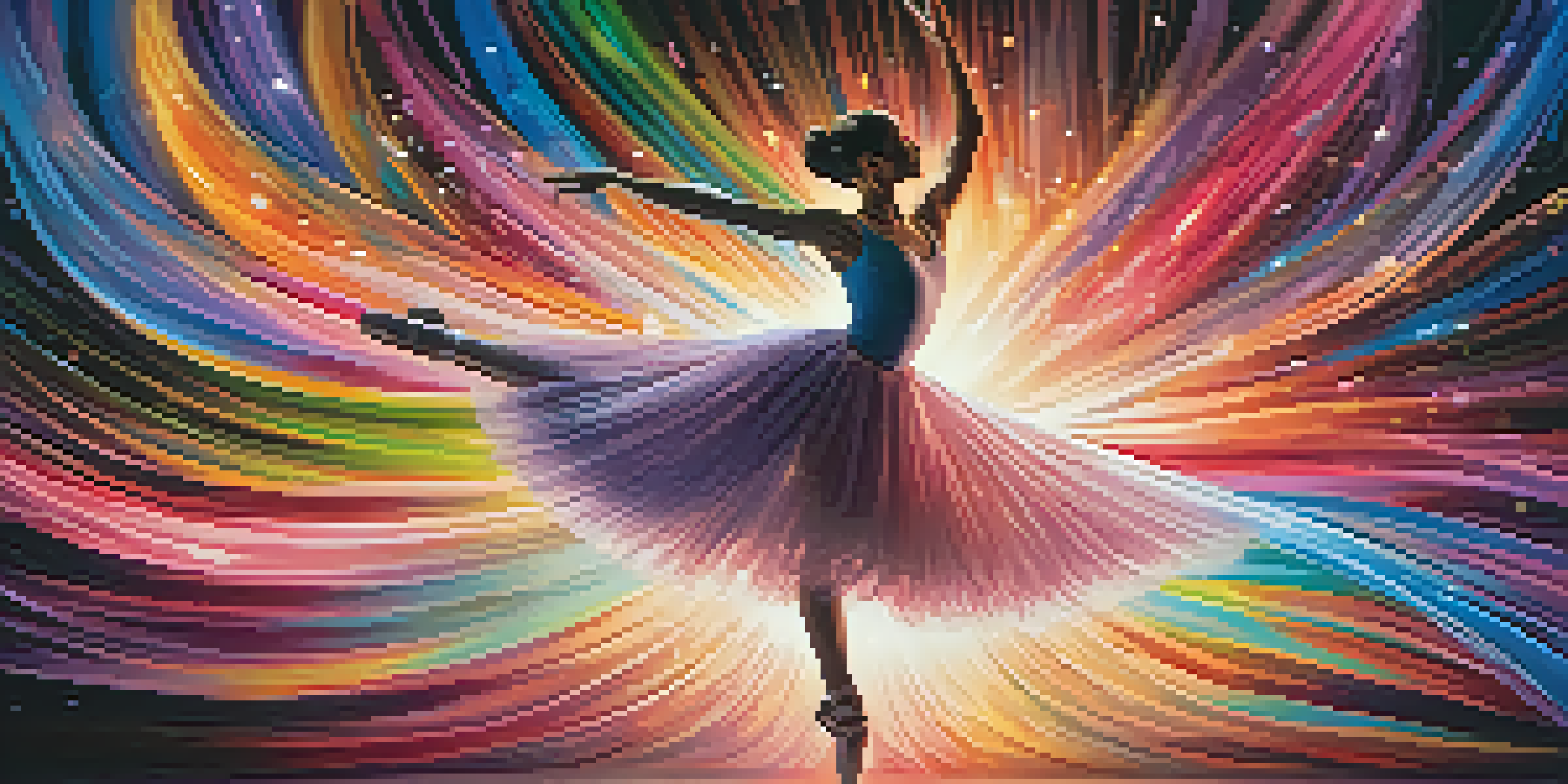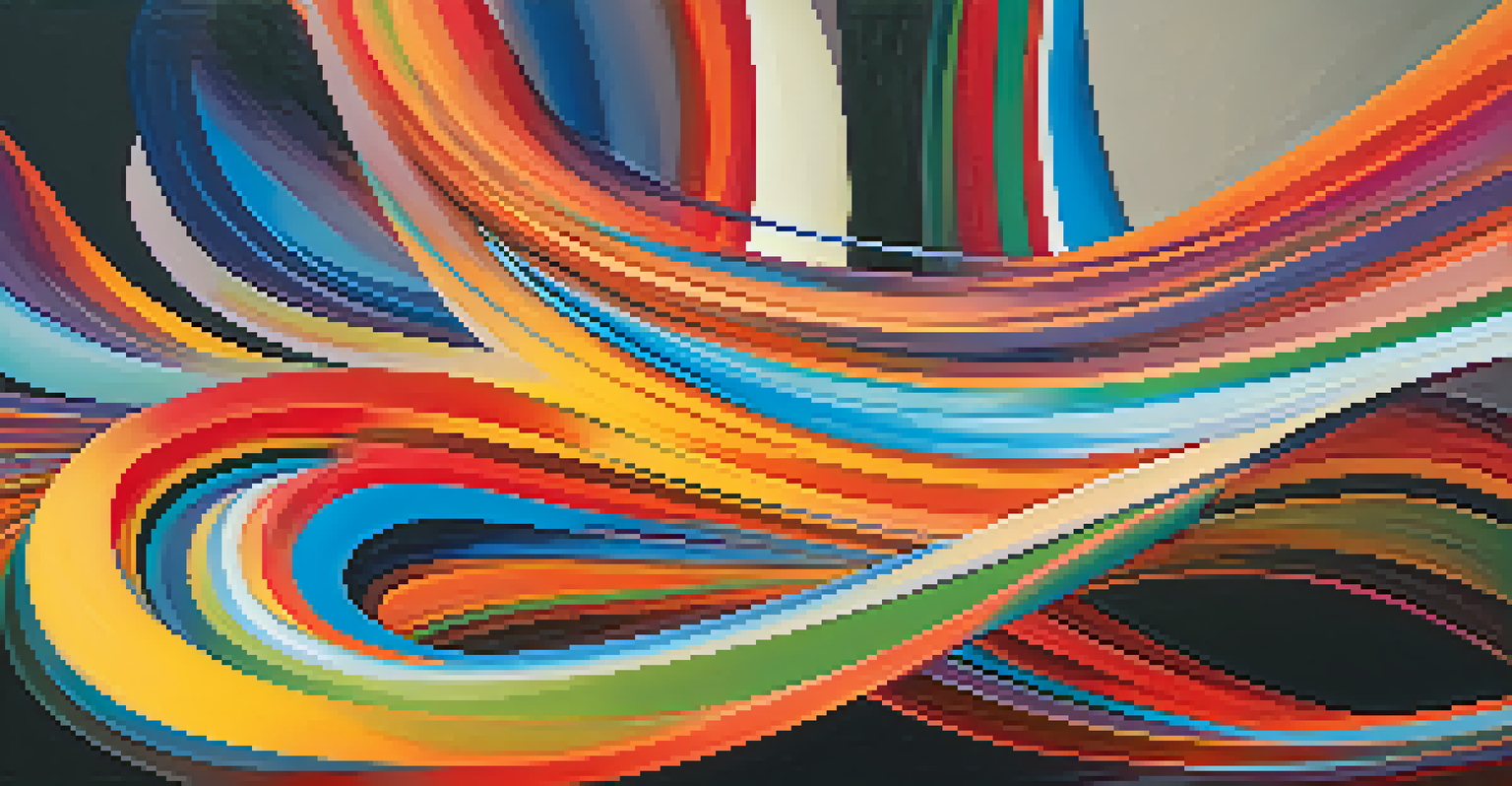Visualizing Music: The Connection Between Dance and Painting

The Art of Movement: Dance as Visual Expression
Dance is often described as a language of movement, where each step and gesture conveys emotions and stories. Just like a painter uses a brush to create a masterpiece on canvas, dancers use their bodies to express feelings and narratives. The fluidity and rhythm of dance can be visualized in the same way one interprets colors and shapes in painting.
Dance is the hidden language of the soul.
When we watch a dancer perform, we experience a visual spectacle that evokes a range of emotions, much like viewing a striking piece of art. Both art forms share the ability to communicate deep feelings without the need for words, creating a universal language that transcends cultural barriers. This connection invites viewers to immerse themselves in the experience, whether through the movement of bodies or the strokes of a paintbrush.
For many artists, the inspiration drawn from dance often translates into their paintings, leading to dynamic compositions that capture the essence of movement. Just as a choreographer might envision a dance, a painter can visualize the rhythm and flow of a performance, illustrating how intertwined these two art forms can be.
Color and Rhythm: The Palette of Dance
Colors play a significant role in both dance and painting, influencing the mood and energy of a performance or artwork. In dance, costumes and lighting can dramatically change how a movement is perceived, much like how an artist uses colors to evoke particular feelings in their paintings. The interplay of light and dark, bright and muted tones can create a rhythm that resonates with the viewer.

Consider a vibrant dance performance set against a backdrop of bold colors; it creates a visual symphony that enhances the overall experience. Similarly, in painting, the use of color can capture the spirit of a dance, translating its energy onto a canvas. This similarity highlights how both disciplines rely on visual elements to communicate ideas and emotions.
Dance and Painting: A Shared Language
Both dance and painting communicate emotions and stories, creating a universal language that transcends cultural barriers.
Artists often take inspiration from the colors and movements they see in dance, resulting in pieces that vibrate with life. The fusion of color and rhythm invites the audience to experience both art forms in a multi-sensory way, deepening their appreciation for the connections between movement and visual expression.
The Dance of Lines: Movement in Painting
Lines in painting can mimic the movement found in dance, creating a visual representation of motion. Just as dancers create shapes and formations with their bodies, artists use lines to guide the viewer's eye across the canvas. These dynamic lines can evoke a sense of flow and rhythm, much like the choreography in a dance performance.
Dance is the hidden language of the soul.
When we look at a painting, the direction and curvature of the lines can suggest movement, inviting us to imagine what comes next. This ability to visualize dance through the medium of paint allows for a unique interplay between the two art forms. For example, a swirling line may evoke the image of a dancer twirling, drawing us into the motion captured in the artwork.
This connection between lines and movement encourages artists to experiment with their techniques, blending the boundaries between visual art and performance. Through this exploration, both painters and dancers can develop a deeper understanding of how their art forms can complement and enhance one another.
Cultural Connections: Dance and Painting in History
Throughout history, many cultures have intertwined dance and visual arts, using both to tell stories and celebrate traditions. From ancient rituals to modern performances, the connection between these two forms has been a vital part of cultural expression. Artists and dancers often draw from their heritage, creating works that reflect their community's values and beliefs.
In many indigenous cultures, dance is an integral part of ceremonies, with visual art playing a crucial role in the storytelling aspect. The vivid colors and patterns in traditional paintings often represent the stories told through dance, creating a rich tapestry of cultural expression. This historical context not only highlights their connection but also emphasizes the importance of preserving these art forms.
Color Enhances Emotional Expression
The interplay of colors in dance and painting significantly influences the mood and energy, deepening audience engagement.
Today, contemporary artists continue to explore this relationship, blending dance and painting in innovative ways. By examining the historical ties between these disciplines, we can gain a deeper understanding of how they influence and inspire each other, enriching our appreciation of both art forms.
The Role of Technology: Bridging Dance and Visual Art
In our digital age, technology has opened up new avenues for artists to merge dance and painting in exciting ways. Innovations such as projection mapping and digital art allow for the visualization of movement in real-time, creating immersive experiences for audiences. This fusion enhances the way we perceive both dance and visual art, blurring the lines between the two.
For instance, choreographers can now collaborate with digital artists to project visuals that interact with dancers, creating a vibrant backdrop that enhances the performance. This dynamic exchange not only captivates the audience but also invites artists to explore new creative possibilities. The result is a multi-dimensional experience that transcends traditional boundaries.
As technology continues to evolve, the potential for merging these two art forms will only expand, leading to innovative collaborations. By embracing digital tools, artists can continue to explore the connection between dance and painting, crafting experiences that resonate with diverse audiences and inspire future generations.
Emotional Resonance: The Impact of Dance and Painting
Both dance and painting have the power to evoke strong emotions, creating a visceral connection between the artist and the audience. When we watch a dancer perform, we may feel joy, sadness, or nostalgia, similar to the feelings we experience when viewing a poignant painting. This emotional resonance is what makes both art forms so powerful and impactful.
The ability to convey complex emotions through movement and color allows artists to connect with their audience on a deeper level. Whether it’s a graceful ballet or a bold abstract painting, the emotions expressed can linger in our minds long after the performance or viewing has ended. This shared experience of emotion fosters a sense of community among audiences and artists alike.
Future Collaborations Enhance Art
The evolution of technology fosters innovative collaborations between dance and painting, creating immersive experiences for audiences.
By exploring the emotional aspects of both dance and painting, we can better appreciate the ways in which they enrich our lives. The connections between these art forms remind us of the beauty of human expression and the profound impact it can have on our emotional well-being.
The Future of Dance and Painting: A Collaborative Journey
As we look to the future, the collaboration between dance and painting is likely to evolve in exciting new ways. Artists are increasingly recognizing the potential for cross-disciplinary projects that explore the connections between movement and visual art. This spirit of collaboration encourages creativity and innovation, resulting in fresh interpretations and experiences.
Future performances may incorporate elements from both dance and painting, inviting audiences to engage with art in unique and interactive ways. Imagine an exhibition where dancers perform amidst live painting, creating a fluid dialogue between the two forms. This kind of collaboration not only entertains but also challenges traditional perceptions of art.

Ultimately, the future of dance and painting lies in their ability to inspire one another. By continuing to explore their connections, artists can create works that resonate with audiences on multiple levels, enriching the cultural landscape and ensuring that these art forms remain vibrant and relevant for generations to come.